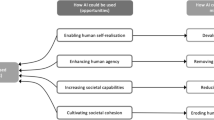Abstract
Water scarcity, changing climate patterns and polluted water bodies have caused the current global water crisis that is threatening many nations around the world. Despite this significant threat, few academic literature references can be found on promoting changes that focus on saving and protecting our planet’s water. In this research, the Protection Motivation Theory [(PMT) Rogers J Psychol 91:93–114, 1975; 1983)] is proposed as an effective model for guiding communication campaigns that support water resource management. PMT is a widely used ‘fear appeal’ model that can persuade audiences to change their behaviors or invoke actions to avoid a negative threat or event. Twenty marketing campaigns focusing on implementing behavior and activities to better manage our water resources were analyzed for their adherence to the PMT. The analysis showed that although a majority of the marketing communications on water resources successfully conformed to PMT, some marketing communications failed to include pertinent PMT factors. Implications on developing marketing communications related to reducing water resources are discussed.

Similar content being viewed by others
References
Arnell N (2004) Climate change and global water resources: SRES emissions and socio- economic scenarios. Global Environ Change 14:31–52
Barlow M (2007) Blue covenant: the global water crisis and the coming battle for the right to water. McClelland & Stewart, Toronto
Bruce S, Tiger M (2010) A review of research relevant to evaluating social marketing mass media campaigns. http://www.nccwep.org/pdf/evaluating-social-marketing-mass-media-campaigns.pdf. Accessed 21 February 2011
Cismaru M, Lavack AM (2010) “Don’t suffer in silence”—applying the integrated model for social marketers to campaigns targeting victims of domestic violence. Soc Market Quart 16:97–129
Cismaru M, Lavack AM, Hadjistavropoulos H, Dorsch KD (2008) Understanding health behavior: an integrated model for social marketers. Soc Market Quart 14:2–32
Cismaru M, Lavack AM, Markewich E (2009) Social marketing campaigns aimed at preventing drunk driving: a review and recommendations. Int Market Rev 26:292–311
Cromwell J, Smith J, Raucher R (2007) Implications of climate change for urban water utilities. Association of Metropolitan Water Agencies (AMWA), Washington, D.C
Dziegielewski B (1994) “The drought is real” Designing a successful water conservation campaign. In: Efficient Water Use, Comission Nacional Del Aqua, Mexico City. http://www.unesco.org.uy/phi/libros/efficient_water/wbendzieg.html. Accessed 20 October 2010
Engel R (2007) Water conservation campaign report. http://www.docstoc.com/docs/68285179/Water-Conservation-Campaign-Report-Advertising-Media. Accessed 11 August 2011
Floyd DL, Prentice-Dunn S, Rogers RW (2000) A meta-analysis of research on protection motivation theory. J Appl Soc Psychol 30:407–429
Gleick PH, Cooley H, Cohen M, Morikawa M, Morrison J, Palaniappan M (2009) Data table 1, total renewable freshwater supply by country. In The world’s water 2008 – 2009. Island Press, Washington, DC
Hershey CR for Cause Communication (2005) Communications toolkit - A guide to navigating communications for the nonprofit world. http://www.causecommunications.org/pdf/cc_toolkit.pdf. Accessed 24 February 2011
Hinrichsen D, Robey B, Upadhyay UD (1997) Solutions for a water-short world. Population reports, Series M, No. 14. Baltimore, Johns Hopkins School of Public Health, Population information program, December 1997
Kantola SJ, Syme GJ, Nesdale AR (1983) The effects of appraised severity and efficacy in promoting water conservation: an informational analysis. J Appl Soc Psychol 13:164–182
Mckenzie-Mohr D, Smith W (2008) Fostering sustainable behavior. An introduction to community-based social marketing. New Society Publishers, Gabriola Island
Milne S, Sheeran P, Orbell S (2000) Prediction and intervention in health related behaviour: a meta-analytic review of protection-motivation theory. J Appl Soc Psychol 30:106–143
Okaka W (2010) Developing regional communications campaigns strategy for environment and natural resources management policy awareness for the East African community. Res J Environ Earth Sci 2:106–111
Osborne D, Walker D, Sparham L (2010) Water for the future communication campaign research. http://www.environment.gov.au/water/publications/action/pubs/water-future-final-report.pdf. Accessed 11 August 2011
Peterson H (2000) Rural drinking water and waterborne illness. In: ‘Maintaining drinking water quality - Lessons from the prairies and beyond’. In: Robertson W (ed) Proceedings of the 9th National conference on drinking water, Regina, Saskatchewan, Canada, May 16 to 18, 2000. Canadian Water and Wastewater Association, Ottawa, Ont, pp 162–191
Perfloff RM, Ray GB (1991) An analysis of AIDS brochures directed at intravenous drug users. Health Commun 3:113–125
Prentice-Dunn S, Rogers R (1986) Protection motivation theory and preventive health: beyond the health belief model. Health Educ Res 1:153–161
Rogers RW (1975) A protection motivation theory of fear appeals and attitude change. J Psychol 91:93–114
Rogers RW (1983) Cognitive and physiological processes in fear-based attitude change: a revised theory of protection motivation. In: Caccioppo J, Petty R (eds) Social psychophysiology: a sourcebook. Guilford, New York, pp 153–176
SalterMitchell, Inc (2009) Water conservation media campaign- Draft posttest Report. http://www.swfwmd.state.fl.us/files/database/social_research/SWFWMDMediaResearchPosttestReportV1b.pdf. Accessed Dec. 20, 2010
Syme GJ, Nancarrow BE, Seligman C (2000) The evaluation of information campaigns to promote voluntary household water conservation. Eval Rev 24:539–578
Tanner J, Hunt J, Eppright D (1991) The protection model: a normative model of fear appeals. J Market 55:36–45
United States Environmental Protection Agency, US EPA (2003) Getting in step. A guide to conducting watershed outreach campaigns. http://www.epa.gov/owow_keep/NPS/toolbox/print/getnstepguide.pdf. Accessed 25 January 2011
World Health Organization, WHO (2011) Water, sanitation and health. http://www.who.int/water_sanitation_health/mdg1/en/index.html. Accessed 25 January 2011
World Water Day (2011) World water day. http://www.worldwaterday.org/page/107 Accessed 12 January 2011
Author information
Authors and Affiliations
Corresponding author
Rights and permissions
About this article
Cite this article
Nelson, K., Cismaru, M., Cismaru, R. et al. Water management information campaigns and protection motivation theory. Int Rev Public Nonprofit Mark 8, 163–193 (2011). https://doi.org/10.1007/s12208-011-0075-8
Received:
Accepted:
Published:
Issue Date:
DOI: https://doi.org/10.1007/s12208-011-0075-8




